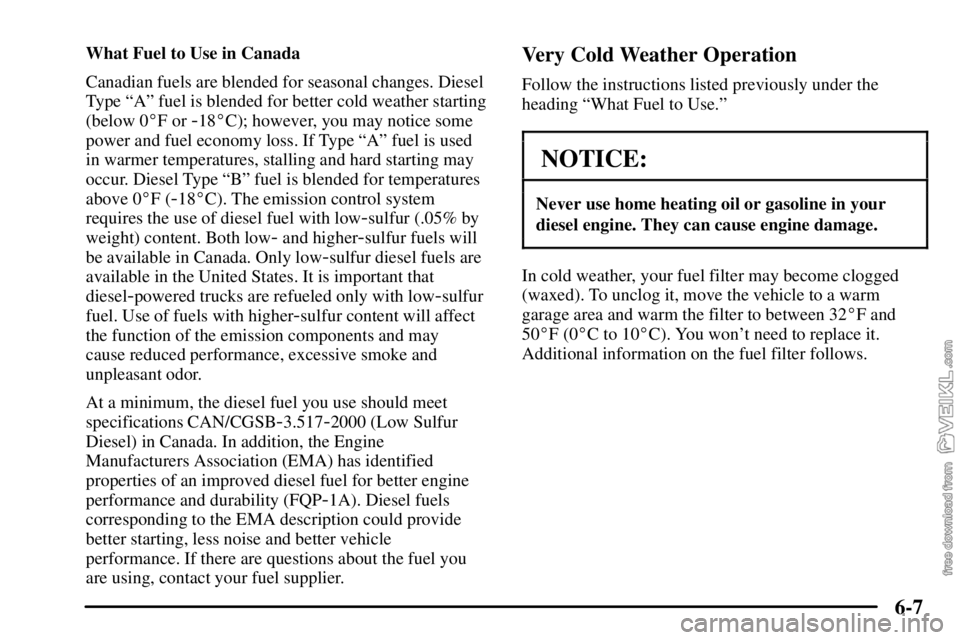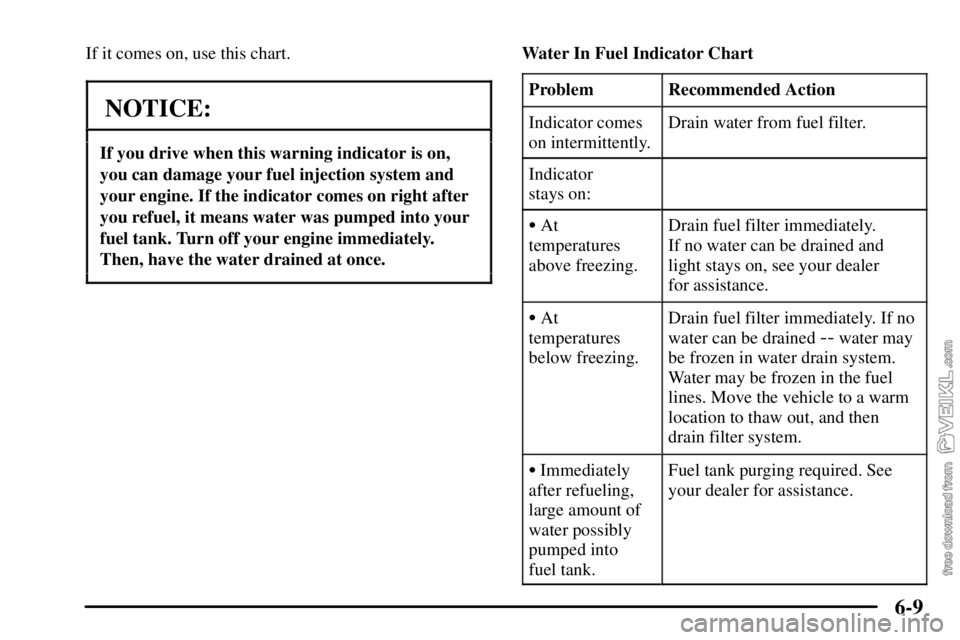Page 258 of 386

6-4
Fuel (Gasoline Engine)
If your vehicle has a diesel engine, see ªDiesel Engine
Fuelº in this section. For vehicles with gasoline engines,
please read this.
Gasoline Octane
Use regular unleaded gasoline with a posted octane of
87 or higher. If the octane is less than 87, you may get
a heavy knocking noise when you drive. If it is bad
enough, it can damage your engine. A little pinging
noise when you accelerate or drive uphill is considered
normal. This does not indicate a problem exists or that a
higher
-octane fuel is necessary.
Gasoline Specifications
It is recommended that gasoline meet specifications
which were developed by the American Automobile
Manufacturers Association and endorsed by the
Canadian Vehicle Manufacturers' Association for better
vehicle performance and engine protection. Gasolines
meeting these specifications could provide improved
driveability and emission control system performance
compared to other gasolines.
In Canada, look for
the ªAuto Makers'
Choiceº label on
the pump.
Canada Only
Additives
Some gasolines that are not reformulated for low
emissions may contain an octane
-enhancing additive
called methylcyclopentadienyl manganese tricarbonyl
(MMT); ask the attendant where you buy gasoline
whether the fuel contains MMT. General Motors does
not recommend the use of such gasolines. Fuels
containing MMT can reduce the life of spark plugs and
the performance of the emission control system may be
affected. The malfunction indicator lamp may turn on.
If this occurs, return to your authorized GM dealer
for service.
Page 259 of 386

6-5
To provide cleaner air, all gasolines in the United States
are now required to contain additives that will help
prevent engine and fuel system deposits from forming,
allowing your emission control system to work properly.
You should not have to add anything to your fuel.
Gasolines containing oxygenates, such as ethers and
ethanol, and reformulated gasolines may be available in
your area to contribute to clean air. General Motors
recommends that you use these gasolines, particularly if
they comply with the specifications described earlier.
NOTICE:
Your vehicle was not designed for fuel that
contains methanol. Don't use fuel containing
methanol. It can corrode metal parts in your
fuel system and also damage plastic and rubber
parts. That damage wouldn't be covered under
your warranty.
Diesel Fuel Requirements and
Fuel System
Diesel Engine Fuel
For the Caterpillar� diesel, see the Caterpillar�
Operation & Maintenance Manual for information
concerning fuel usage.
NOTICE:
Diesel fuel or fuel additives not recommended in
this manual could damage your fuel system and
engine. Your warranty wouldn't cover this
damage. And:
�Diesel fuel that has been mixed with engine
oil could damage your engine and emission
controls.
�If you ever run out of diesel fuel, it can be
difficult to restart your engine. To avoid all
this, never let your tank get empty.
If you run out of fuel, ªRunning Out of Fuel,º later in
this section, tells you how to restart your engine.
Page 260 of 386

6-6 What Fuel to Use
In the United States, for best results use Number 2-D
diesel fuel year
-round (above and below freezing
conditions) as oil companies blend Number 2
-D fuel to
address climate differences. Number 1
-D diesel fuel
may be used in very cold temperatures (when it stays
below 0�F or
-18�C); however, it will produce a power
and fuel economy loss. Avoid the use of Number 1
-D
diesel fuel in warm or hot climates. It may result in
stalling, poor starting when the engine is hot and may
damage the fuel injection system.
At a minimum, the diesel fuel you use should meet
specifications ASTM D975
-00 (Grade Low Sulfur) in
the United States. In addition, the Engine Manufacturers
Association (EMA) has identified properties of an
improved diesel fuel for better engine performance and
durability. Diesel fuels corresponding to the EMA
Recommended Guideline on Premium Diesel Fuel
(FQP
-1A) could provide better starting, less noise and
better vehicle performance. If there are questions about
the fuel you are using, contact your fuel supplier.Diesel fuel may foam when you fill your tank. This can
cause the automatic pump nozzle to shut off, even
though your tank isn't full. If this happens, just wait for
the foaming to stop and then continue to fill your tank.
CAUTION:
Heat coming from the engine may cause the fuel
to expand and force the fuel out of your tank. If
something ignites the fuel, a fire could start and
people could be burned. To help avoid this, fill
your fuel tank only until the automatic nozzle
shuts off. Don't try to ªtop it off.º
Page 261 of 386

6-7
What Fuel to Use in Canada
Canadian fuels are blended for seasonal changes. Diesel
Type ªAº fuel is blended for better cold weather starting
(below 0�F or
-18�C); however, you may notice some
power and fuel economy loss. If Type ªAº fuel is used
in warmer temperatures, stalling and hard starting may
occur. Diesel Type ªBº fuel is blended for temperatures
above 0�F (
-18�C). The emission control system
requires the use of diesel fuel with low
-sulfur (.05% by
weight) content. Both low
- and higher-sulfur fuels will
be available in Canada. Only low
-sulfur diesel fuels are
available in the United States. It is important that
diesel
-powered trucks are refueled only with low-sulfur
fuel. Use of fuels with higher
-sulfur content will affect
the function of the emission components and may
cause reduced performance, excessive smoke and
unpleasant odor.
At a minimum, the diesel fuel you use should meet
specifications CAN/CGSB
-3.517-2000 (Low Sulfur
Diesel) in Canada. In addition, the Engine
Manufacturers Association (EMA) has identified
properties of an improved diesel fuel for better engine
performance and durability (FQP
-1A). Diesel fuels
corresponding to the EMA description could provide
better starting, less noise and better vehicle
performance. If there are questions about the fuel you
are using, contact your fuel supplier.
Very Cold Weather Operation
Follow the instructions listed previously under the
heading ªWhat Fuel to Use.º
NOTICE:
Never use home heating oil or gasoline in your
diesel engine. They can cause engine damage.
In cold weather, your fuel filter may become clogged
(waxed). To unclog it, move the vehicle to a warm
garage area and warm the filter to between 32�F and
50�F (0�C to 10�C). You won't need to replace it.
Additional information on the fuel filter follows.
Page 263 of 386

6-9
If it comes on, use this chart.
NOTICE:
If you drive when this warning indicator is on,
you can damage your fuel injection system and
your engine. If the indicator comes on right after
you refuel, it means water was pumped into your
fuel tank. Turn off your engine immediately.
Then, have the water drained at once.
Water In Fuel Indicator Chart
Problem
Recommended Action
Indicator comes
on intermittently.Drain water from fuel filter.
Indicator
stays on:
� At
temperatures
above freezing.Drain fuel filter immediately.
If no water can be drained and
light stays on, see your dealer
for assistance.
� At
temperatures
below freezing.Drain fuel filter immediately. If no
water can be drained
-- water may
be frozen in water drain system.
Water may be frozen in the fuel
lines. Move the vehicle to a warm
location to thaw out, and then
drain filter system.
� Immediately
after refueling,
large amount of
water possibly
pumped into
fuel tank.Fuel tank purging required. See
your dealer for assistance.
Page 264 of 386

6-10
To drain water, do the following:
1. Stop and park the vehicle in a safe place. Turn off
the engine and apply the parking brake.
2. Remove the fuel cap.
3. Place a fuel
-resistant container under the fuel filter.
The filter drain valve is located on the bottom of the
fuel filter. The fuel filter is located in the engine
compartment on the passenger's side of the vehicle,
or on the driver's side frame rail near the engine.
4. Open the drain valve by
turning two to three
turns. When fuel
empties from the valve,
all the water has been
drained. Close the valve
hand tight.5. Remove the fuel
-resistant container and properly
dispose of the contaminated fuel. To find out how to
properly dispose of contaminated diesel fuel, see
ªWhat to Do with Used Oilº in the ªEngine Oil
(Diesel Engines)º part, later in this section.
6. Install the fuel cap.
7. Start the engine and let it run for a few minutes.
If the engine stalls, the fuel system may need to be
primed. While draining the water from the fuel filter,
air may enter the fuel system. If air has entered the
fuel system the fuel system will need to be primed.
Refer to ªFuel Primingº later in this section.
If the water in fuel indicator comes on again after
driving a short distance or the engine runs rough or
stalls, a large amount of water has probably been
pumped into the fuel tank. The fuel tank should
be purged.
Fuel Priming
In order for the DURAMAX diesel engine fuel system
to work properly, the fuel lines must be full of fuel and
contain no air. If air gets into the fuel lines, it will be
necessary to prime the fuel lines to eliminate air before
operating the vehicle.
Page 265 of 386

6-11
Q:How does air get into the fuel lines?
A:One of the following may have happened:
�The vehicle ran out of fuel, or
�The fuel filter was removed for servicing or
replacement, or
�The fuel lines were removed or disconnected for
servicing, or
�The fuel filter water drain valve was opened while
the engine was running.
If one or more of the above occur, it is very likely that
air has entered your fuel system and that you will need
to prime the fuel system before operating the vehicle.
Air in the fuel lines will not harm the engine or
the vehicle.
However, the engine may not be able to start until the
fuel system is primed and the air is removed.
Q:How do I prime the vehicle?
A:Your vehicle is equipped with a priming pump
which is part of the engine mounted fuel filter.
The vent valve and the fuel filter primer pump
are located on top of the fuel filter housing. The
priming pump is hand operated and is designed to
bring fuel to the engine to eliminate any air that
may be in the fuel lines.
To prime the engine, do the following:
1. Make sure there is fuel in the tank.
2. Make sure the fuel filter had been installed and
properly tightened.
3. Make sure the fuel lines are properly connected and
the fuel filter is cool enough to touch.
4. Remove any dirt from the fuel filter head and vent
valve by wiping with a cloth.
Page 266 of 386
6-12
5. Open the fuel filter vent
valve by turning the
screw counterclockwise
several full turns.
6. Repeatedly press down
on the fuel filter primer
pump with the palm
of your hand. Let the
pump return upward
between presses.7. Operate the priming pump until a small amount of
fuel seeps from the vent valve. When you see the
fuel, the filter is now full of fuel and the system
should be primed.
8. Close the vent valve.
9. Clean any fuel which accumulated on the fuel filter.
10. Start the engine and let it idle for a few minutes.
11. Check the filter for leaks.